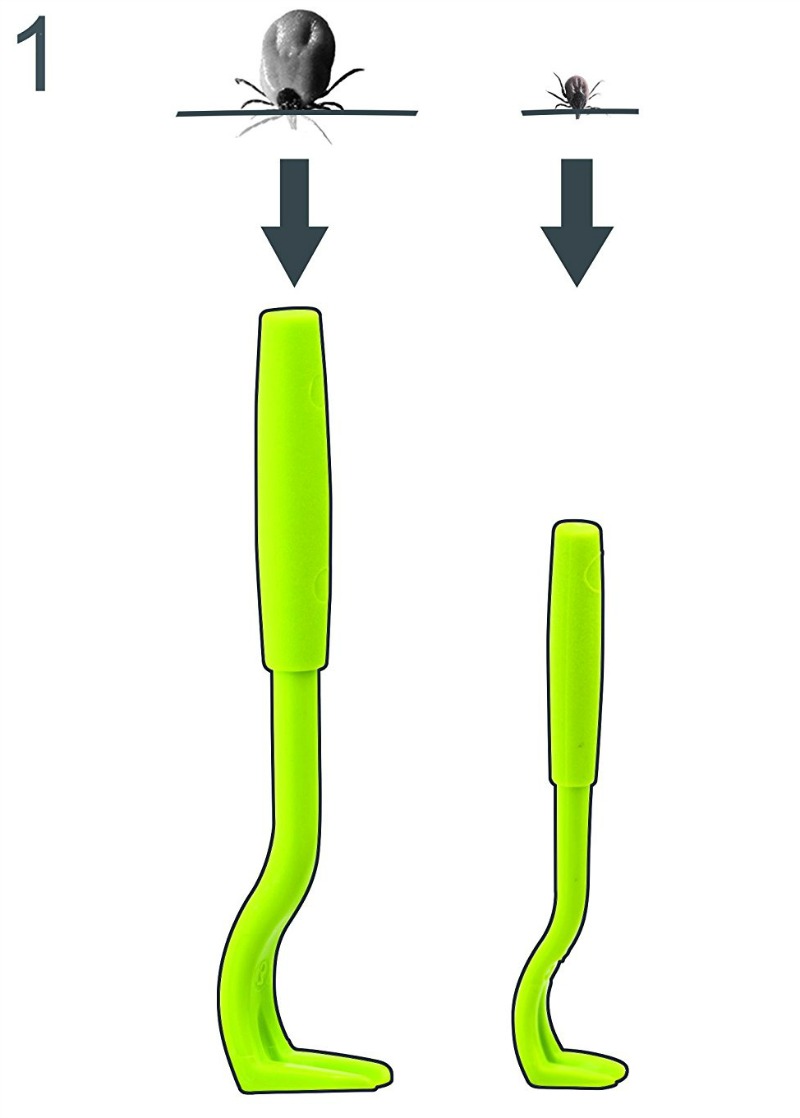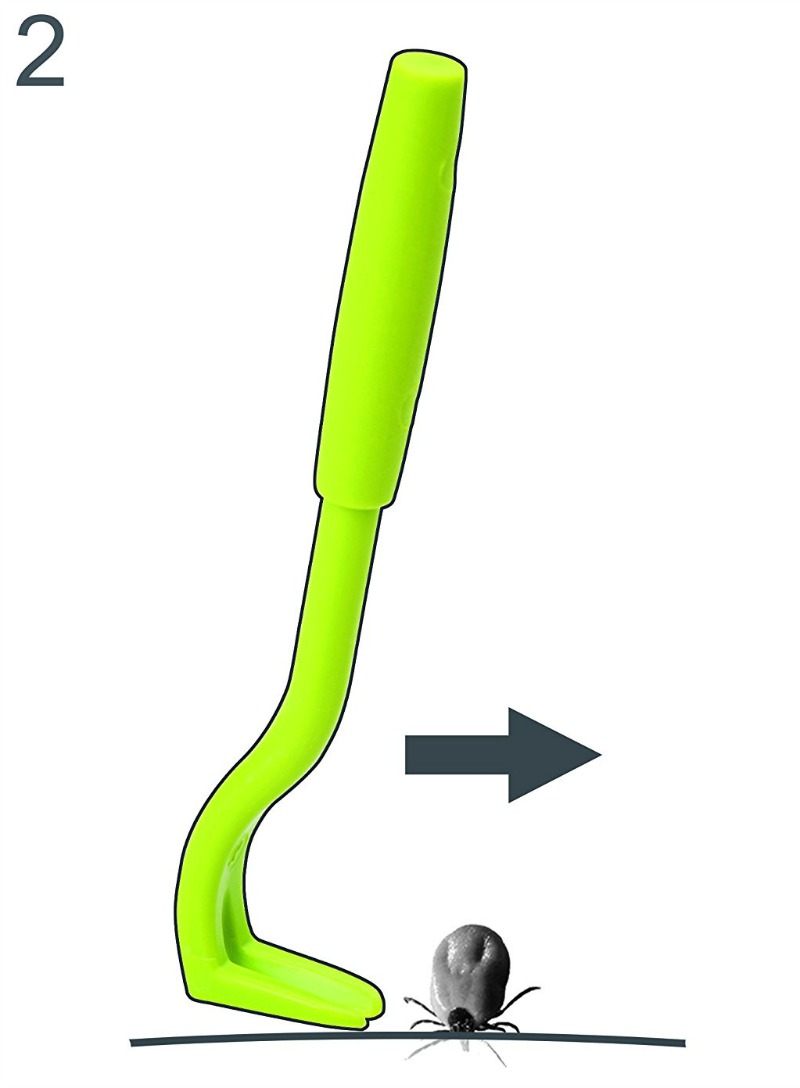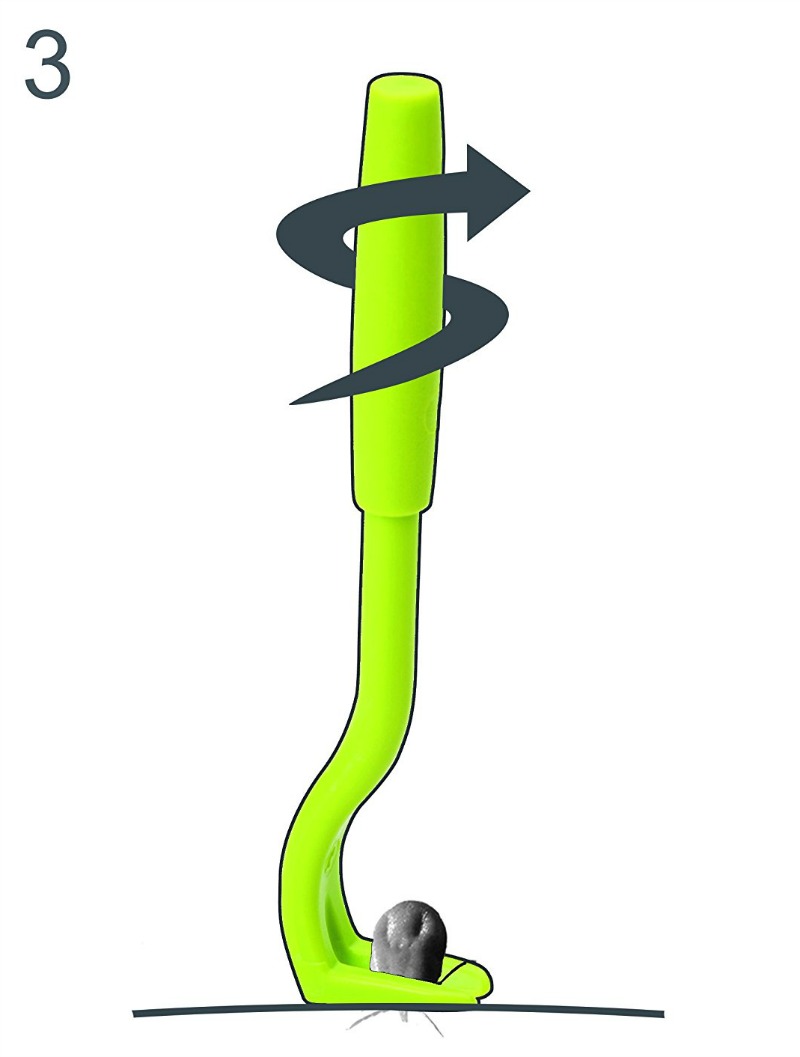Safe method to remove a tick without leaving the head stuck in the skin that works with small or large ticks and is easier than tweezers.

Each spring and summer, warmer weather and spending more time outside and camping outdoors increases the chances of exposure to nasty tick bites. The question is not “if” but “when” it will happen. And, when it inevitably does, how to remove a tick safely to minimize the chances of disease?
I have a friend who lives on a farm in Kentucky with his wife and five children. During tick season, he and his wife perform tick checks every night on all their children right before bathtime. They take ticks very seriously in their home because the Lyme disease carrying kind are very prevalent in their area.
It’s not just Lyme disease that is a potential risk either. The Journal of General Internal Medicine published an article by Susan Wolver, MD, and Diane Sun, MD, which identified a rising trend of red meat allergies from tick bites.
When one of my children was a fairly young baby and not even mobile yet, a tick lodged itself into the top of his head. Most likely, the tick dropped out of a tree onto his head, so don’t think your children are safe just because they aren’t hiking in the woods or walking in the grass!
If you discover that your child or pet has a tick that has lodged itself into the skin, here is the safest, easiest and quickest way to remove it.
How to Remove a Tick Safely and Quickly
The best way to remove ticks is using tweezers according to most authoritative sources. However, there is a new gadget called the tick twister remover that works even better.
My friend in Kentucky says that they used to use tweezers, but the tick twister is far superior and easier to use. It can be used to remove ticks from both pets and people.
Each tick twister tick removal set (it only costs about $6) has two removers inside: one large and one small. The different size is to allow for safe removal of both small and large ticks.
This ingenious device created by a veterinarian to safely remove ticks regardless of a person’s expertise has the following benefits:
- It is easier to use than tweezers especially for small ticks.
- It removes the tick without squeezing it, which greatly reduces the chances of disease transmission.
- It ensures the head and mouthparts of the tick are removed along with the body.
- It can be used for both large and small ticks.
Every home with children and/or pets should have one of these! It should also be included with camping equipment.
Safe Removal Steps. Better than Tweezers!
There are three steps for removing a tick using the tick twister.
First, you select which tick twister to use. If the tick is large, use the larger tick twister. If the tick is small, use the smaller one. Pretty simple!

Second, you grasp the tick between the head and body using the hook end of the tick twister. The picture below shows how to do it.

Third, simply twist the tick twister gently to easily and safely remove the entire tick out of the skin. That’s it!

After removing the tick, thoroughly clean the affected skin with alcohol. If there is any irritation, a dab of this herbal salve does wonders to quickly heal the skin.
Warning About some Tick Removal Recommendations
Some sources recommend pulling a tick straight out of the skin as the best method of removal.
This is very dangerous advice, because trying to pull a tick straight out will almost ALWAYS result in the head staying stuck in the skin. This is because ticks frequently lodge into the skin at an angle. They don’t usually burrow straight in perpendicular to the skin’s surface.
If you must use tweezers because you don’t have the tick twister remover available, be sure to pull the tick out at the same angle it went in.
This will give you the best shot at removing the head along with the body. In other words, grab the tick very firmly and close to the head as you can and pull out on a straight line but the same angle it burrowed in. I hope this makes sense.
It’s a little difficult to describe in words. This is the method taught to me by my Dad, who is a retired family doctor. Using this method, I’ve never left a tick’s head in the skin of any pet or person in over 40 years.
Of course, using the inexpensive tick twister is the best method of all. You don’t have to worry about angles – you simply twist the tick out of the skin!
How to Repel Ticks
This article describes the method for preparing an herbal yarrow tincture which is very effective at repelling ticks so you don’t have to remove them in the first place.
You ideally need to spray yourself every 2 hours or so.
Note that yarrow has been reputedly found by the US Army to be as effective as DEET in repelling ticks.








We discovered Tick Twisters last year; they make it very easy to remove the ticks. After removal, I seal the tick into a piece of tape (Scotch or surgical, both work equally well), and then then write the date on the tape with a Sharpie, and put it in the Tick box.
I’m wondering about the Tick Twisters now…they come out very easily, but could they be getting irritated by the spinning. The last thing I want is for my family and pets to be a tick’s barf bucket!
Jennifer, if it’s twisting the tick, it’s the wrong thing. Just pull straight out. You’re much more likely to tear off the head or mouthparts by twisting the tick than pulling it gently straight out. It didn’t twist its way in there, so there’s no purpose in twisting it to pull it out. When I first moved to an area with ticks, well-meaning people recommended twisting them, and I remember having occasional problems with heads or mouthparts left behind. Now I pull them straight out and it’s been years since I’ve had anything break off. This is definitely a case where the obvious (and “official”) solution really is the best.
Absolutely agree with Judith and the others warning about the misinformation in this post. This post is simply a re-wording of a random unverified email citing a random unnamed “School Nurse” to give credibility to a collection of urban legends about ticks. So it’s no surprise that most of the “facts” given are wrong. The whole thing needs to be taken down.
“Also, if the tick has a white spot on it’s back it is a Deer Tick, so after you have removed the tick, place it in a bag and go visit the doctor for examination of the tick and yourself. Deer Ticks can sometimes carry Tick Fever!”
As others here have mentioned, the tick with a spot is a Lone Star Tick, not a Deer Tick, and neither variety carries anything called Tick Fever, although they can spread several other nasty diseases. Colorado Tick Fever occurs only in the western part of the US, and is carried by the Wood Tick, Dermacentor andersoni.
Frequently the tick’s head will be left in the skin this way and this scenario leaves the skin vulnerable to infection.”
“Trying to pull a tick straight out will almost ALWAYS result in the head staying stuck in the skin.”
We live in a heavily-wooded part of Oklahoma and pull multiple attached ticks off us or our children nearly every day. Should probably use an instrument to pull them off but we pull them straight off by hand, holding near the skin and squeezing as little as possible (easy if they haven’t been attached long), and it’s been years since I’ve seen mouth parts left behind.
“SNOPES claims that the liquid soap method is not effective and recommends using a pair of tweezers to pull the tick straight out, but this is not what old time country doctors recommend.”
The authority of these “old time country doctors” would be a little more convincing if Sarah would cite her sources. I suspect their credentials are about as solid as that elusive “School Nurse” of the unsourced email.
“you must pull the tick out at an angle which will give you the best shot at removing the head along with the body.”
Again, simply nonsense. Don’t do this. I’ve removed hundreds of ticks by gently pulling straight out without any heads left behind.
Finally, Sarah, I’m all for skepticism regarding “official” health information, but if your only alternative is quoting a completely unverified random email full of urban legends that seemed cool… please hire a fact-checker or something so it doesn’t happen again. And please take this post down. It’s seriously damaging your credibility.
For real tick information, try the following links:
For tick-borne diseases:
http://www.columbia-lyme.org/index.html
For tick identification:
http://tickinfo.com/
For tick removal:
http://www.cdc.gov/ticks/removing_a_tick.html
Yes it’s the CDC and yes that technique works perfectly.
They also have information about ticks and tick-borne diseases.
I disinfect afterwards and put a green clay cataplasm on the wound as I believe it draws out anything foreign (it is used as a post vaccin measure, when avoidance has proved impossible)
Wish I’d seen this 2 weeks ago. My son had a tick embedded in his head then. We didn’t save it. Since then, I’ve heard that tea tree oil will make it back out of the skin as well. Or nail polish remover being the best. But the liquid soap is super easy to find. Thanks!
Adrienne, it’s appears the tick backing out on it’s own is dangerous and it should be immediately remove with the least irritation to the tick as possible. There are dozens of comments to that effect on this blog post. It may increase the risk of transmitting disease from the tick to the person with the tick if he is made to back out or release his grip on his own.
It is disheartening to see people continue to post all the ways they have irritated ticks to get them to detach so neatly. People, please read the posts above that explain why this is dangerous to your health. Don’t make ticks detach themselves and don’t injure them or put anything on them. Don’t turn them over or handle them in any way. I sound like a broken record, I know. But doing any of those things puts you in danger. An irritated tick will puke its gut contents into the bite wound in order to detach, potentially giving you a serious disease. The disease organisms stay down in the gut for hours after the tick attaches. Do you want them injected into your body? No? Then don’t fool around with the tick at all! You want to pull the tick out with a tool that grasps it at the head, not breaking open the tick’s body at all. Don’t do anything else. Pull it off, and do it immediately. I hope you will read this and look at my other posts here, and post by other people with quotes that back this up, from real experts. It could save your life.
Thanks Judith for your time here fighting the good fight. I believe this blog post marks an internet first for me: a blogger “debunking” a Snopes article by citing no less an authority than the very email the Snopes article was written to debunk. It’s staggering. Here’s hoping she has the good grace to take it down.
Sarah – I am appreciating your desire to help, but you are losing credibility with me on this one. I’m with Judith and others about not putting anything on ticks that MIGHT make them regurgitate their gut contents introducing Lyme’s disease, if the tick is a carrier. Lyme’s is serious business. I too have friends who have had major health problems from Lyme’s disease they got from a tick.
Judith – thanks for your persistent comments warning people of the danger of using a topical agent to remove ticks and also sharing your experience about how to use tweezers to effectively remove them. Hopefully I will never need to use it, but glad to know it from someone who has done it so many times!
I was just on a hike last weekend and went to scratch my neck and found a tick. Fortunately it had not dug in yet and I pulled it off with just my fingers like a tiny bit of velcro.
“Lyme” disease is far from the only serious tick disease we have in North America. It is very common in the NE, and less common elsewhere, though it is spreading and should always be kept in mind. There is a fair amount in California, though most people there are not aware of it.
We have a few of the ehrlichias and anaplasmas that affect people, and several that affect dogs. We have Babesia, Bartonella, and RMSF. I’m sure I forgot a few! (All of these affect dogs and can be fatal.) RMSF can be rapidly fatal, and it’s good to know symptoms and get treated ASAP if you think you have it. The others are more chronic and develop somewhat more slowly, but can be fatal, or disabling for life.
New strains and new diseases are being discovered. A new ehrlichia was discovered in Wisconsin recently. And there is STARI, much like Lyme, in the Southeast but spreading, for which I believe there is still no test. It is treated like Lyme.
Go to the tick links I posted for complete info.
Ticks became such a serious issue due to the Lyme disease epidemic. All types of ticks carry Lyme in the NE and most carry many other bugs included in the “Lyme” spectrum. Unfortunately ticks survive baths and much more. If it was engorged for more hours, do not waste any time. Immediately get on Doxycycline for at least 20 days, not the 10 days that most docs might recommend. I never use drugs, and I hate antibiotics but this is one of the very few cases I would accept taking them.
Ticks became such a serious issue due to the Lyme disease epidemic. All types of ticks carry Lyme in the NE and most carry many other bugs included in the “Lyme” spectrum.
Unfortunately ticks survive baths and much more. If it was engorged for more hours, do not waste any time. Immediately get on Doxycycline for at least 20 days, not the 10 days that most docs might recommend. I never use drugs, and I hate antibiotics but this is one of the very few cases I would accept taking them.
I agree this post should be pulled and another posted. I wrote “twisted” above but of course the tick should be pulled straight out gently.
I’ll never forget the day my 11 yr old daughter came home from a school excursion of hide and seek in the forest with about 30 ticks of all sizes all over her body. We needed a magnifying glass to find all the ticks and especially the nymphs, which were just the color of her skin. The tiny hole in the tick tweezers was too large to get the nymphs, but a fine tweezers did the trick. She’s been very careful ever since.
Years before, when I had a tick bite and went to a rheumatologist to have it pulled, he twisted it out quickly saying he’d been so quick that it hadn’t had time to regurgitate its contents. I promptly came down with Lyme disease.
Going to a doctor for tick removal is not necessary, and some of us would be there several times a week if we did this! It’s expensive, but it also delays tick removal for a long time, and that can make you sick. The most important thing is to get the tick off before it transmits disease, which means in the first 12-24 hours, possibly even sooner. The second is to get it off safely. Just pulling it off in the recommended way with an appropriate tool will do that. No need to twist. See my link above to Tickencounter, with excellent directions for removal.
We always apply rubbing alcohol do loosen the tick’s hold then use tweezers to pull out, or if the tick was missed and has dug in have someone with very steady hands that you trust very much use an extremely sharp fillet knife to get under the head and dig the tick out if done properly there should be no blood and the tick should come out whole and undamaged.
These are both dangerous methods. Please read my posts here. Look at some of the links I posted for expert information. Others have posted great links. Either approach puts you in danger; cutting a tick out with a knife is totally unnecessary. A find-pointed tweezers or tick removal took is all you need. Do not make the tick loosen!